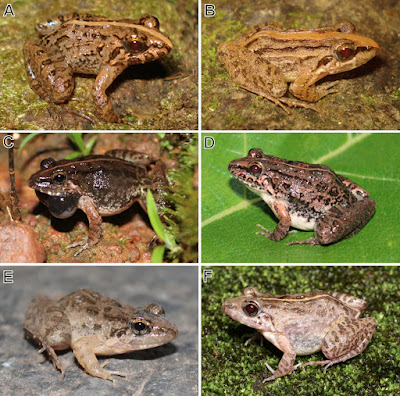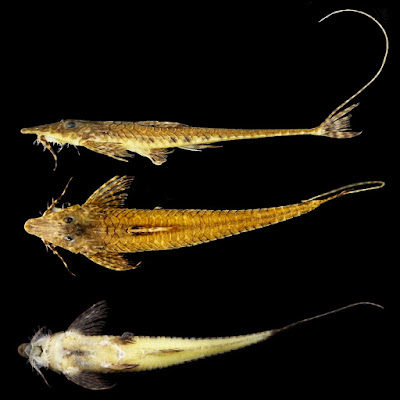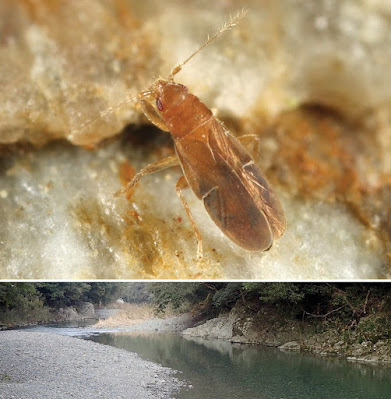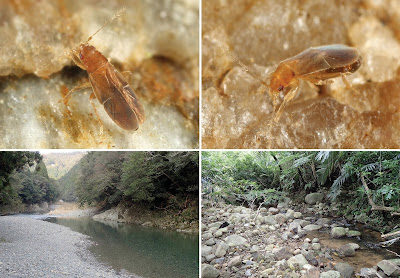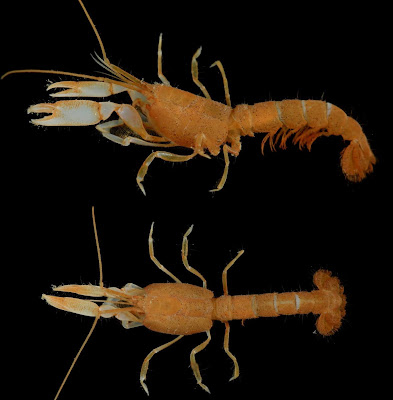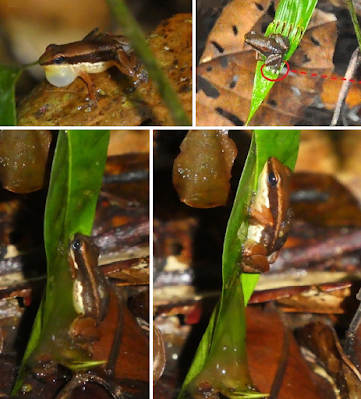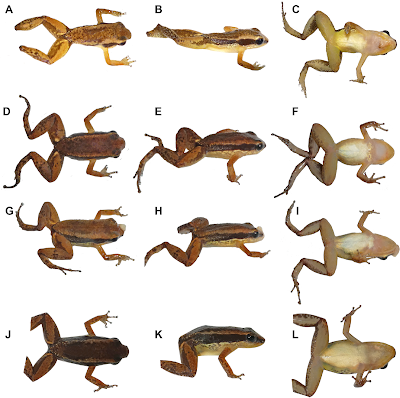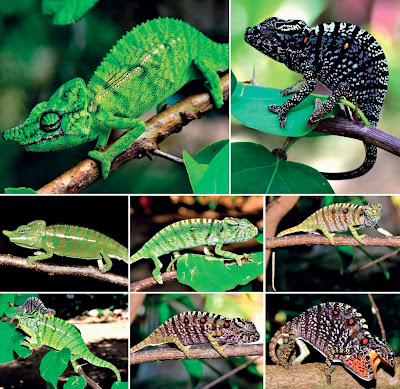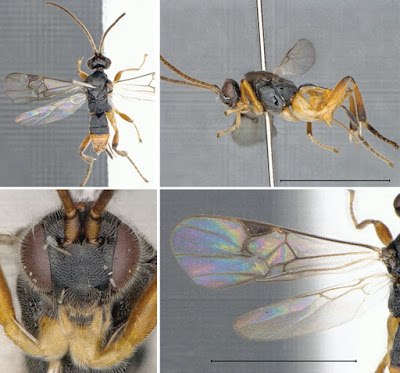[Most Recent Entries] [Calendar View]
Wednesday, November 4th, 2020
| Time | Event | ||||||
| 2:25a | [Herpetology • 2020] Importance of Genetic Data in Resolving Cryptic Species: A Century Old Problem of Understanding the Distribution of Minervarya syhadrensis Annandale 1919 (Anura: Dicroglossidae) Abstract Frogs of the genus Minervarya are cryptic and widely distributed in South Asia. However, many of them lack information about the precise type locality, genetic data, and distribution range. The present study aimed to examine the genetic affinities of a widely distributed species Minervarya syhadrensis around its type locality in the northern Western Ghats (Pune, Maharashtra). We studied the type specimen of M. syhadrensis and collected similar sized Minervarya frogs from Pune district. In the field, we observed two different calls from morphologically similar (M. syhadrensis like) males suggesting the sympatric occurrence of two cryptic species (that we initially named Minervarya species A and Minervarya species B). We analyzed morphology, call pattern, and mitochondrial 16S rRNA gene sequence of both species. Minervarya species A has a long call with a low pulse repetition rate and higher dominant frequency compared to that of the Minervarya species B. These species cannot be differentiated based on morphometric data. However, they can be sorted out using morphological characters such as the presence of longitudinal skin folds on the dorsal side (Minervarya species A) and differences in foot webbing. DNA sequences of Minervarya species A and Minervarya species B are matching with those of M. caperata and M. agricola respectively. After studying the type specimens of M. syhadrensis and M. caperata, we found morphological similarities (longitudinal skin folds) with the samples of Minervarya species A collected during the present study. Based on the results of our study (morphology and genetic) and available literature, we propose to redefine M. syhadrensis as applying to the lineage initially named Minervarya species A, and to treat the species M. caperata as a junior synonym of M. syhadrensis. Our study will be helpful in further taxonomic revision of the genus, and provides natural history information for M. syhadrensis and M. agricola. Keywords: Amphibia, Advertisement call, cryptic species, Minervarya syhadrensis, Minervarya caperata, integrative taxonomy
Samadhan Phuge, Ajinkya Bharatraj Patil, Radhakrishnan Pandit, Nirmal U. Kulkarni, B.H. Channakeshava Murthy, P. Deepak and K.P. Dinesh. 2020. Importance of Genetic Data in Resolving Cryptic Species: A Century Old Problem of Understanding the Distribution of Minervarya syhadrensis Annandale 1919, (Anura: Dicroglossidae). Zootaxa. 4869(4); 451–492. DOI: 10.11646/zootaxa.4869.4.1 | ||||||
| 7:04a | [Ichthyology • 2020] New Finding of Rhadinoloricaria macromystax (Siluriformes: Loricariidae): Redescription of the Genus and Description of A New Species from Ecuador
Abstract The fish collection from the Museum of Escuela Politécnica Nacional, Quito, Ecuador, has nine lots with 12 specimens assigned to genus Rhadinoloricaria. Specimens come from the Napo and Pastaza rivers, Amazon River basin, eastern Ecuador. One specimen matches accurately with figures and original description of Loricaria macromystax Günther, 1869, type species of Rhadinoloricaria. After 150 years, this is the first secure identification of the species, which allowed an accurate description of the genus Rhadinoloricaria, and the discovery of a new species from Ecuador, described herein. In addition, using available specimens, figures and literature, a comparative analysis on external morphology was performed among the eight species included in Rhadinoloricaria. The analysis documented significant differences between them, in some morphological external characters and in buccal ornamentation. The results suggest that the eight species can be grouped into three or four genera. Rhadinoloricaria, in strict sense, has two species. Apistoloricaria is considered a valid genus, and include the four species previously assigned to it. Rhadinoloricaria bahuaja and R. rhami do not belong to the known genera in the Pseudohemiodon group. At this time, available data suggests that both species could continue included in ‘Rhadinoloricaria’, waiting further analyses to solve their generic status. Results support the use of buccal ornamentation patterns alone or combined with some morphological characters as valuable tool for generic identification within Loricariini. Keywords: Pisces, Amazon River, Buccal characters, Diversity, Freshwater fishes, Taxonomy
Rhadinoloricaria Isbrücker & Nijssen, 1974 Rhadinoloricaria Isbrücker & Nijssen, 1974, Beaufortia, 22(290):73. Type species: Loricaria macromystax Günther, 1869 by original designation. Rhadinoloricaria macromystax (Günther, 1869) Rhadinoloricaria stewarti, new species Etymology. The specific epithet honors Donald S. Stewart, in recognition of his contributions to the knowledge of the freshwater fishes, especially the Napo River, Ecuador. Francisco Provenzano-Rizzi and Ramiro Barriga-Salazar. 2020. New Finding of Rhadinoloricaria macromystax (Siluriformes: Loricariidae): Redescription of the Genus and Description of A New Species from Ecuador. Zootaxa. 4779(4); 485–500. DOI: 10.11646/zootaxa.4779.4.2 | ||||||
| 7:17a | [Entomology • 2019] Two New Species of the Genus Cryptostemma (Hemiptera: Heteroptera: Dipsocoridae) from Japan
Abstract Cryptostemma miyamotoi sp. nov. and C. pavelstysi sp. nov. from Japan are described. Habitus images and illustrations of diagnostic features, including genitalic structures, are provided. A key to the Eastern Palaearctic species is offered to facilitate identification. Habitats and behavior of the two new species are discussed based on the field and laboratory observations. The gender agreement of Pachycoleus japonicus (Miyamoto, 1964) is corrected. Keywords: Hemiptera; Heteroptera; Dipsocoromorpha; Dipsocoridae; Cryptostemma; Pachycoleus; bionomics; new species; taxonomy; Japan; Palaearctic Region Kazutaka Yamada and Masami Hayashi. 2019. Two New Species of the Genus Cryptostemma from Japan (Hemiptera: Heteroptera: Dipsocoridae). Acta Entomologica Musei Nationalis Pragae. 59(2); 381-390. | ||||||
| 7:44a | [Invertebrate • 2019] Philomontanus gen. nov. • Multigene Phylogeny reveals A New Earthworm Genus (Oligochaeta: Lumbricidae) with Three New Species from Iran
Abstract Lumbricidae taxonomy is vastly restricted by the morphological simplicity of earthworms and their lack of complex appendices. This has led to confusing results in the Lumbricidae classifications, which in turn, has hindered our ability to identify and assign new and cryptic species to the family. Here we propose the addition of a new Lumbricidae genus from the Zagros and Elburz Mountains of Iran, i.e. Philomontanus gen. nov., including three new species. Our taxonomic inferences were based on the phylogenetic analysis of two nuclear gene regions (28S rDNA and 18S rDNA) and 11 mitochondrial gene regions (16S rDNA, 12S rDNA, NADH dehydrogenase I, cytochrome oxidase subunits I and II and tRNAs Asn, Asp, Val, Leu, Ala and Ser). Philomontanus gen. nov. comprises the earthworm species Philomontanus sarii sp. nov., Philomontanus mahmoudi sp. nov. and Philomontanus baloutchi sp. nov. These three species are morphologically similar to each other with only a few characters separating them (e.g. size, pigmentation and position of clitellum). Our findings support the adoption of an integrative approach including molecular information (e.g., DNA sequences) to aid earthworm classification and develop a robust taxonomy. Taxonomy Phylum Annelida Lamarck, [1802] Class Oligochaeta Grube, [1850]/ Clitellata Michaelsen, [1919] Order Megadrilli Benham, [1890] /Haplotaxida Michaelsen, [1900] Family Lumbricidae Rafinesque-Schmaltz, 1815 Genus Philomontanus gen. nov. Diagnosis: Setae widely distant. Pigmentation variable, red-violet or totally pale. Prostomium epi- or tanylobous. First dorsal pore around 7/8. Male pore on 15 very small, on setal line bc. Clitellum annular. Spermathecae, which are small and round shaped present, frequently empty in 9/10–10/11 and open in setal line cd. Tubercula pubertatis ribbon shape. Nephridiopores aligned in setal bc. Two pairs of testes and funnels in segments 10–11, not iridescent. Four pairs of seminal vesicles in 9–12, those in 11 and 12 are slightly smaller than others. Two pairs of small, roundly shaped and almost empty spermathecae in 9/10 and 10/11 and open in setae line cd. Calciferous glands in segments 11 with hardly recognizable diverticula. Excretory system holoic, nephridial bladders ocarina shape. Typhlosole simple lamelliform, the cross-section of longitudinal muscle layer is of pinnate type. Since the morphological characters above are not sufficient to pinpoint the taxonomic position of Philomontanus in the Lumbricidae, we have used phylogenetic analysis of DNA sequences to determine its taxonomic position and closest relatives. Type species: Philomontanus sarii sp. nov. by original designation herein. Included species: Philomontanus sarii sp. nov., P. mahmoudi sp. nov. and P. baloutchi sp. nov. Etymology. Philomontanus is composed of Philo (Greek prefix means liking for specified thing) and montanus (Latin noun means mountains). This name has been chosen as new genus and its three species have been found in mountains.
Philomontanus sarii Bozorgi & Malek sp. nov. Etymology. The new species name was chosen to honor Dr. Alireza Sari, who has done extensive research on various aspects of Iranian fauna. Philomontanus mahmoudi Bozorgi & Malek sp. nov. Etymology. The new species is named in memory of coauthor Masoumeh Malek’s father. Philomontanus baloutchi Bozorgi & Malek sp. nov. Etymology. The new species is named in memory of Dr. Mohammad Baloutch, who was a prominent zoology professor in Iran. Farnaz Bozorgi, Marjan Seiedy, Masoumeh Malek, Manuel Aira, Marcos Pérez-Losada and Jorge Domínguez. 2019. Multigene Phylogeny reveals A New Iranian Earthworm Genus (Lumbricidae: Philomontanus) with Three New Species. PLoS ONE. 14(1): e0208904. DOI: 10.1371/journal.pone.0208904 | ||||||
| 8:16a | [Crustacea • 2020] Strianassa lerayi • A New Laomediid Mud-shrimp (Malacostraca: Decapoda: Gebiidea) from the eastern Pacific, with New Records of Axianassa ngochoae and Heteroaxianassa heardi in the western Pacific
Abstract A new laomediid genus, Strianassa gen. nov., is established to accommodate a new eastern Pacific species of mud-shrimp, Strianassa lerayi sp. nov. The holotype and single specimen of the new species was collected on a shallow subtidal flat at Isla Afuerita, Canales de Afuera, Coiba Archipelago, Panama. Strianassa gen. nov. appears to be most closely related to Axianassa Schmitt, 1924 and Heteroaxianassa Sakai, 2016, differing from both of them by the dorsal surface of the rostrum armed with teeth; the third maxilliped with an exopod and a set of setobranchs; and the epipodal complex of the fourth pereiopod including a small podobranch. In addition, Axianassa ngochoae Anker, 2010 and Heteroaxianassa heardi (Anker, 2011) are recorded for the first time from New Caledonia and Papua New Guinea, respectively, representing minor extensions of their previously known distributional ranges. The validity of Heteroaxianassa is discussed. Keywords: Decapoda, Laomediidae, mud-shrimps, Axianassa, Heteroaxianassa, new genus, new species, East Pacific, West Pacific, Crustacea
Family Laomediidae Borradaile, 1903 Genus Strianassa gen. nov. Etymology. The generic name combines the official abbreviation of the Smithsonian Tropical Research Institute / Instituto Smithsonian de Investigaciones Tropicales / STRI (Stri-) and the last six letters of the genus Axianassa (-anassa), a superficially similar and phylogenetically putatively closely related genus. Gender feminine. Type species. Strianassa lerayi sp. nov., by monotypy and present designation. Distribution. Presently known only from the tropical eastern Pacific. Strianassa lerayi sp. nov. Etymology. The new species is named after the author’s friend and colleague, Dr. Matthieu Leray, for his invitation to participate in the highly successful expedition to the Coiba Archipelago in February 2019, during which three new genera and one new species of decapod crustaceans were collected and described (Anker 2020a, 2020b, 2020c; present study). Distribution. Presently known only from the type locality in the Coiba Archipelago, Pacific coast of Panama. Arthur Anker. 2020. Strianassa lerayi gen. et sp. nov., A New Laomediid Mud-shrimp from the eastern Pacific, with New Records of Axianassa ngochoae Anker, 2010 and Heteroaxianassa heardi (Anker, 2011) in the western Pacific (Malacostraca: Decapoda: Gebiidea). Zootaxa. 4820(3); 523–539. DOI: 10.11646/zootaxa.4820.3.6 Strianassa lerayi Anker, New Shrimp Species From Panama’s Coiba National Park | ||||||
| 1:58p | [Herpetology • 2020] Allobates velocicantus • A New Nurse Frog (Anura: Aromobatidae) from Brazilian Amazonia with A Remarkably Fast Multi-noted Advertisement Call
Abstract Nurse frogs (Aromobatidae: Allobates) are probably the most extensively studied genus by taxonomists in Brazilian Amazonia. The southwestern portion of Amazonia is the most species-rich: as many as seven species may occur in sympatry at a single locality. In this study, we describe a new species of nurse frog from this region. The description integrates data from larval and adult morphology, advertisement calls and DNA sequences. Allobates velocicantus sp. nov. is distinguished from other Allobates mainly by the absence of hourglass-shaped dark marks on the dorsum and dark transverse bars on the thigh; a throat that is white centrally and yellow marginally; basal webbing on toes II and III; finger I longer than finger II; and an advertisement call composed of 66–138 pulsed notes with a note duration of 5–13 ms, inter-note intervals of 10–18 ms and a dominant frequency of 5,512–6,158 Hz. Tadpoles of the new species have 3–4 short, rounded papillae on the anterior labium, 16–23 papillae on the posterior labium, and a labial keratodont row formula 2(2)/3(1). This is the fifth species of Allobates described from the state of Acre, southwestern Brazilian Amazonia. Allobates velocicantus sp. nov. Allobates sp. CdS MCP10187 (MCP10188) Grant et al. (2017). Diagnosis. Allobates velocicantus sp. nov. is characterized by (1) small size, SVL 14.9–16.2 mm in males and 16.0–17.4 mm in females; (2) dorsal color pattern predominantly light brown, with no dark patches and marks; (3) dorsum granular; (4) dark brown lateral stripe from the tip of the snout to the groin; (5) light dorsolateral stripe absent or inconspicuous in living specimens but present in preserved specimens; (6) light but incomplete ventrolateral stripe; (7) oblique lateral line diffuse; (8) snout slightly rounded in dorsal view; (9) tympanum inconspicuous; (10) paired dorsal digital scutes; (11) supernumerary tubercles absent; (12) distal tubercle absent on finger IV; (13) discs moderately expanded on fingers I–IV; (14) finger I slightly larger than finger II; (15) finger III of males with similar width along phalanges; (16) dermal lateral fringes and webbing absent on fingers; (17) metacarpal ridge absent; (18) carpal pad absent; (19) excrescences on thumbs absent; (20) dark gland on arm absent; (21) basal webbing present between toes III and IV; (22) metatarsal tubercle present; (23) light “half-moon” shaped paracloacal mark; (24) superior eyelids dark brown; (25) iris metallic bronze; (26) pupil large, black, horizontal semielliptical; (27) transverse bars on thigh absent; (28) dark brown spots on tibia; and (29) advertisement calls formed by 66–138 pulsed notes (emitted in multiple exhalations) with a dominant frequency of 5,512–6,158 Hz. Etymology. The specific epithet is derived from the Latin words velox (= fast) and cantus (= singing), in reference to the high note-repetition rate of the advertisement call of the new species. Proposed standard English name: fast singer frog. Proposed standard Spanish name: sapito del canto veloz. Proposed standard Portuguese name: sapinho do canto acelerado. Phylogenetic placement. The new species is assigned to the genus Allobates based on its phylogenetic position presented in the present study and in Grant et al. (2017). Natural history notes. Allobates velocicantus sp. nov. inhabits the litterfall of primary and secondary lowland ombrophilous open forest (Fig. 10A). Populations of this species were found in terra firme forest either close to or distant from small forest streams. The new species uses leaves of small shrubs in the forest understory as egg deposition sites; two clutches (nine tadpoles and 13 eggs) were found in this situation. On 13–15 February 2019, during the middle of the rainy season, males were found calling between 8:00 and 18:00 h, and always perched between 10 and 30 cm above the ground. A pair of adults was observed courting: the male was leading the female to an egg deposition site, and he emitted a courtship call while both frogs were moving. As the male started emitting another advertisement call, the female stopped following. Arriving at the egg deposition site, the male jumped on to a leaf (adaxial surface), which was located around 20 cm above the ground, and continued to emit advertisement calls interspersed with courtship calls. After a few moments, the female jumped to the leaf with the male and approached him, initially touching snouts before turning her back to him. The male then jumped onto the female’s dorsum, while also sliding its hand to her head. The male remained in that position—cephalic amplexus—for 2 min before jumping from the leaf. The female remained in place for a few moments but then began moving, turning clockwise 30°, stopping, and repeating that pattern several times, always turning clockwise. The length of time the female stopped between movements ranged from 2 to 10 min, while she deposited eggs (Fig. 10C). Overall, egg deposition lasted 40 min before the female abandoned the leaf, leaving behind a clutch of 13 eggs. Each egg had a distinctly pigmented animal pole and was encased within cloudy jelly (Fig. 10D). The clutch was collected immediately after the female abandoned it, the embryos maintained alive through hatching, and the resulting tadpoles reared to Gosner stages 27–37 before being sacrificed and preserved. The second egg clutch had nine tadpoles at aquatic-transport stage. The male (INPAH 41347) jumped onto the egg clutch and made circular movements inside it, at which time the tadpoles began to wriggle towards his dorsum, eventually climbing onto it (Figs. 10E–10G). This event lasted for 5 min. Conclusion: Allobates velocicantus is differentiated from its congeners based on external morphology of adults and tadpoles, advertisement call and molecular analyses. The species represents an excellent model to study the ecological and physiological adaptations to solar radiation on eggs of Allobates. However, the conservation of A. velocicantus is threatened by the expansion of illegal logging, cattle ranching, and agriculture. Jesus R.D. Souza, Miquéias Ferrão, James Hanken and Albertina P. Lima. 2020. A New Nurse Frog (Anura: Allobates) from Brazilian Amazonia with A Remarkably Fast Multi-noted Advertisement Call. PeerJ. 8:e9979. DOI: 10.7717/peerj.9979 | ||||||
| 2:02p | [Ichthyology • 2020] Hidden or Unnoticed? Multiple Lines of Evidence Support the Recognition of A New Species of Pseudocorynopoma (Characidae: Corynopomini)
Abstract Species delimitation is a permanent issue in systematics. The increasing recognition of geographically isolated populations as independent lineages allowed by new methods of analysis has inflated the species‐populations dilemma, which involves deciding whether to consider separate lineages as different species or structured genetic populations. This is commonly observed between fishes of adjacent river basins, with some lineages being considered allopatric sister species and others considered isolated populations or variants of the same species. Pseudocorynopoma doriae is a characid diagnosed from its single congener by the number of anal‐fin rays and sexually dimorphic characters of males, including distinct fin colouration. The authors found variation in the colour pattern between isolated populations previously identified as P. doriae but no variation in scale or fin‐ray counts. They analysed molecular evidence at the population level and morphological differences related to life history (e.g., colour dimorphism related to inseminating behaviour). The results provide compelling evidence for the recognition of a new species of Pseudocorynopoma despite the lack of discrete differences in meristic data. The recognition of the new species is consistent with biogeographical evidence for the long‐term isolation of the respective river drainages and with differences between the ichthyofaunal communities of these rivers. Keywords: cryptic species, molecular phylogeny, phylogeography, population genetics, species concept, Stevardiinae Pseudocorynopoma stanleyi new species Habitat and ecological notes: Pseudocorynopoma stanleyi is a typical surface feeder. This species feeds mainly on allochthonous arthropods, especially insects, even in fall and winter months (May, June, July and August) when they are less abundant in subtropical areas (Graciolli et al., 2003). This fish is especially abundant under trees found along stream shores and usually disappears in stretches that have the gallery forest removed. Etymology: The specific epithet stanleyi is in honour of Stanley H. Weitzman in recognition of his great contribution to the knowledge on the stevardiine characids and other Neotropical freshwater fishes. A genitive noun. Luiz R. Malabarba, Junior Chuctaya, Alice Hirschmann, Eduardo Bitencourt de Oliveira and Andréa T. Thomaz. 2020. Hidden or unnoticed? Multiple Lines of Evidence Support the Recognition of A New Species of Pseudocorynopoma (Characidae: Corynopomini). Journal of Fish Biology. DOI: 10.1111/jfb.14572 | ||||||
| 2:24p | [Herpetology • 2020] Rediscovery, Conservation Status and Genetic Relationships of the Malagasy Chameleon Furcifer voeltzkowi (Squamata: Chamaeleonidae)
Abstract The chameleon Furcifer voeltzkowi (Boettger, 1893) from northwestern Madagascar was considered to be a synonym of Furcifer rhinoceratus for many decades and was resurrected only recently based on studies of the morphology and osteology of a few male specimens, which were collected more than 100 years ago. However, basic data on this species remain unavailable, including its conservation status, life history, colouration in life, morphology of the female, genital morphology of the male, phylogenetic affinities, and genetic differentiation from F. labordi and other congeners. During a targeted expedition, we rediscovered F. voeltzkowi in its natural habitat close to its type locality, allowing us to fill some gaps of knowledge. Furcifer voeltzkowi is a sexually dimorphic species. The life colouration of males is largely green, whereas that of females is highly variable and can be extremely colourful. Both, morphology and life colouration of males and females show close similarities to F. labordi from west and southwest Madagascar, but also a number of distinct differences (e.g. a larger size of F. voeltzkowi and a smaller rostral appendage in both sexes), enabling a clear distinction of the two species in both sexes. DNA sequences of the nuclear CMOS gene and two mitochondrial markers (16S rRNA and ND4) also confirm that F. voeltzkowi is a distinct species and sister to F. labordi (pairwise differences in the 16S gene 3.5–3.6%). We estimate the distribution range (extent of occurrence) of F. voeltzkowi to comprise ca. 1.000 km2 and suggest that it qualifies as Endangered B1ab(iii) under the IUCN Red List Criteria as its populations are expected to be severely fragmented, and there is continuing decline in the extent and quality of its habitat. Similar to F. labordi, F. voeltzkowi might be an extremely short-living chameleon with a post hatching life span of only several months in the rainy season. The assumed short life might also partly explain why this splendid species got “lost” for many decades, since most roads in its habitat are not accessible in the wet season. Key words. Squamata, Chamaeleonidae, morphology, molecular genetics, rediscovery, conservation. Furcifer voeltzkowi (Boettger, 1893) Frank Glaw, David Prötzel, Falk Eckhardt, Njaratiana A. Raharinoro, Rojo N. Ravelojaona, Timon Glaw, Kathrin Glaw, Julia Forster and Miguel Vences. 2020. Rediscovery, Conservation Status and Genetic Relationships of the Malagasy Chameleon Furcifer voeltzkowi. SALAMANDRA. 56(4); 342–354. salamandra-journal.com/index.php/home/co | ||||||
| 2:55p | [Entomology • 2020] Microgaster godzilla • An Unusual New Parasitoid Wasp Species (Hymenoptera: Braconidae) from Japan which Dives Underwater to Parasitize Its Caterpillar Host (Lepidoptera, Crambidae)
Abstract A new species of Microgastrinae (Hymenoptera: Braconidae) parasitoid wasp, Microgaster godzilla Fernandez-Triana & Kamino, is described from Japan. From a biological and morphological perspective this is a very unusual species. It represents only the third known microgastrine to be aquatic, and the first one to be found entering the water. The female wasp searches for its hosts, aquatic larvae of Elophila turbata (Lepidoptera: Crambidae), mostly by walking over floating plants, but occasionally diving underwater for several seconds to force the larva out of its case, when it is quickly parasitized (parasitization was always observed above water). The unique searching behaviour of M. godzilla as well as its parasitization of aquatic larvae was filmed and it is presented here. The wasp has simple tarsal claws, which are elongate and strongly curved, similar to those found in the related genus Hygroplitis; they seem to represent an adaptation for gripping to the substrate when entering the water. The new species is described based on morphological, molecular (DNA barcoding), biological and ethological data. Additionally, we provide detailed diagnoses to recognize M. godzilla from all other described species of Microgaster and Hygroplitis in the Palearctic, Nearctic and Oriental regions. Keywords: aquatic parasitoid, biology, Lepidoptera, Microgastrinae, Nearctic, Oriental, Palearctic, parasitoid behaviour, taxonomy
Microgaster godzilla, Fernandez-Triana & Kamino, sp. nov. Diagnosis: Among all described species of Microgaster this species can be distinguished because of its unique combination of morphological characters. Color patterns are distinctive, especially having all legs almost entirely yellow (only apical 0.1 of metafemur, apical 0.3 of metatibia and metatarsus are dark brown to black), tegula dark brown, pterostigma brown, and metasoma dorsally with T1–T2 black and T3+ orange-yellow. Very few Microgaster species have all coxae yellow, and then the color of the tegula and/or metasoma dorsally is usually different. Beyond color, the combination of flagellomeres with relatively distinct setae (bristly), eyes convergent ventrally, face dull due to transverse, rugose sculpture (including indication of vermiculate rugosities towards sides), notauli barely marked by impression or sculpture (and overall sculpture of anteromesoscutum with fine and relatively shallow punctures), scutellar disc mostly smooth, mesopleuron without strong crenulated sulcus, T2 and T3 about same length, T3+ smooth, all tarsi with last segment enlarged, and large but simple tarsal claws are also of diagnostic value. Microgaster godzilla shares some features with the described species of Hygroplitis, most of which also have light-coloured legs, including all coxae in many species, large tarsal claws, and last segments of tarsi enlarged. However, most Hygroplitis species have the body depressed, notauli are strongly marked, antennae have three rows of placodes and the mesopleuron has a strong, crenulated sulcus. Although there is no available key that covers all described Hygroplitis and Microgaster, we found that all Palearctic, Nearctic and Oriental species previously described in those two genera differ from the diagnosis provided above for M. godzilla by at least one (usually more) characters. To facilitate future work on the genus we provide one-to-one comparisons of M. godzilla with every other previously described species of those two genera in the biogeographical regions relevant to the new species (see Suppl. material 5 for detailed comparisons). Distribution: The species has only been collected in the prefectures of Osaka and Kyoto in Honshu, Japan. Etymology: The species is named after Godzilla (Japanese: ゴジラ, Hepburn: Gōjira), a fictional monster (kaiju) that became an icon after the 1954 Japanese film of the same name and many films afterwards. The wasp name is intended to respectfully honour one of the most recognizable symbols of Japanese popular culture worldwide. The wasp’s parasitization behaviour bears some loose resemblance to the kaiju character, in the sense that the wasp (after diving underwater to search for its host, a moth caterpillar) suddenly emerges from the water (to parasitize the host), similar to how Godzilla suddenly emerges from the water in the movies. Additionally, Godzilla has sometimes been associated, albeit in different ways, with Mothra (Japanese: モスラ, Hepburn: Mosura) another kaiju that is typically portrayed as a larva (caterpillar) or adult moth. Jose Fernandez-Triana, Tetsuyuki Kamino, Kaoru Maeto, Yutaka Yoshiyasu and Norio Hirai. 2020. Microgaster godzilla (Hymenoptera, Braconidae, Microgastrinae), An Unusual New Species from Japan which Dives Underwater to Parasitize Its Caterpillar Host (Lepidoptera, Crambidae, Acentropinae). Journal of Hymenoptera Research. 79: 15-26. DOI: 10.3897/jhr.79.56162 |
| << Previous Day |
2020/11/04 [Calendar] |
Next Day >> |
